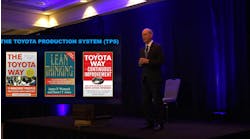Viewpoint: The Keys to Making 'Customer-Facing' Strategies Work
The April issue of IndustryWeek featured an article titled "New Celanese Chief Pushes Customer-Facing Strategy." In the story, Celanese Corp. (IW 500/153) CEO Mark Rohr said, "In other words, we're finding ways to go beyond just talking to the customer and actually going in and bringing solutions to them."
The importance he attaches to becoming customer facing is not unique. Even among firms that are best defined by the products generated from their R&D departments and laboratories, more executives say they're adopting a customer-facing strategy.
And many customers are taking notice, relating success stories about new products, services, business systems and other innovations their suppliers are bringing to their companies.
Unfortunately, customers also have horror stories to tell about their suppliers. This often involves a failure in implementation, suppliers that in some way failed to deliver on their commitments and promises to their customers.
Again, the dimensions of implementation failure are many: late deliveries, short shipments, products that don't work, calls that weren't returned, service personnel that didn't show up, wrong answers provided by technical support teams -- the list goes on and on.
Build a Customer-Facing Culture
I provide those generalizations about success stories involving innovation and horror stories involving implementation failures to underscore the importance of building a customer-facing culture throughout every department in your company.
In the vast majority of the success stories and horror stories that we've heard, the focus wasn't on the supplier's sales organization or its account management team. Rather, the success story originated with the product-development team, the customer-service team, the installation team, the logistics team or some other part of the supplier's organization.
Similarly, the horror stories in almost all circumstances originated in parts of the supplier's organization that had been largely unconnected to the customer prior to the incident that defined the horror story.
Building a customer-facing culture throughout a company is a difficult task for any leader. After all, unlike the sales organization and the strategic accounts team, individuals in other job functions have many day-to-day assignments that don't involve interactions with customers.
For many of these individuals, the customer-facing assignment even seems like an add-on task, possibly even in the "make-work" category. It often goes to the end of the queue in terms of priorities. The goal of building a customer-facing culture is laudable, but the challenge of doing so is enormous.
Among best-practice firms that have achieved success in building a customer-facing culture, all of them have a clear plan for their interactions with customers.
Blueprint for a Customer-Facing Strategy
One corporate executive who several years ago said he intended to make his company more customer-facing described his thinking as follows:
"Soon after I got onto the customer-facing bandwagon, I asked myself 'Why do I believe in this?' That question started off a process, which we implemented for each of our most important customer relationships. I got a team together, from all parts of the company. And we sat together and tried to answer the question: 'What could we accomplish if we had a better relationship with this customer?' Some of the people in the room had never met anyone in that customer organization, but everyone had ideas and opinions. What came out of this process was a blueprint for what it meant, customer by customer, to be customer-facing. And we then knew what to do and who to involve."
Leaders with a plan can bring clarity, energy, and an active cadence to their interactions with customers. They can create the right connections between their own people and the appropriate people in the customer organization.
Such connections can then be purposeful, avoiding the 'it's just more make work' kiss of death so often experienced.
Customer interactions can be focused on the future, oriented towards specific goals and timetables, with concrete measurement systems in place to ensure that progress occurs.
It takes a real commitment -- and usually a very proactive and effective leader - to jumpstart effective relationships with customers.
And it's very easy to back slide and return to a low energy, infrequent mode of interacting. If you and your organization are going to make a commitment to customer relationships, make it real and make it work.
George F. Brown, Jr. is the CEO and cofounder of Blue Canyon Partners Inc., a consulting firm working with leading business suppliers on growth strategy. Along with Atlee Valentine Pope, he is the author of "CoDestiny: Overcome Your Growth Challenges by Helping Your Customers Overcome Theirs," published by Greenleaf Book Group Press of Austin, Texas.
See also:
Celanese Chief Pushes Customer-Facing Strategy



